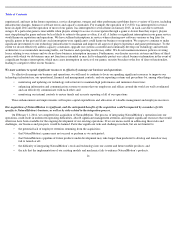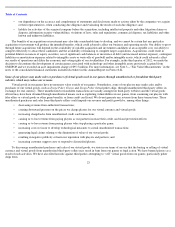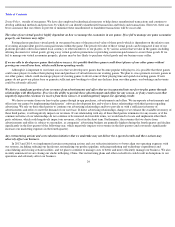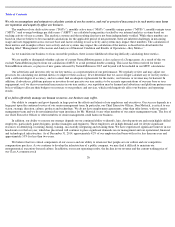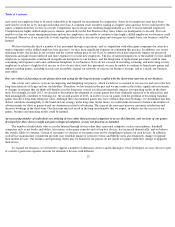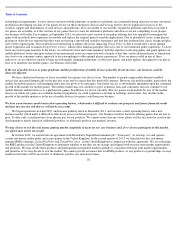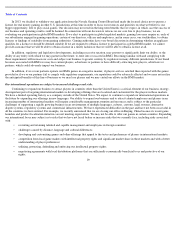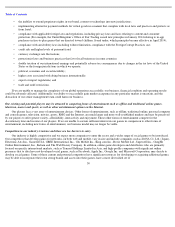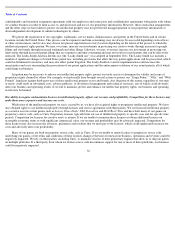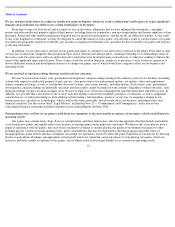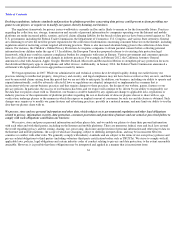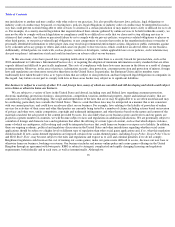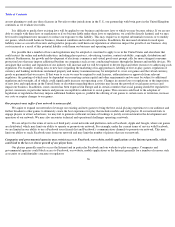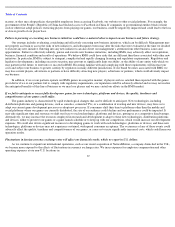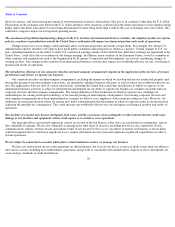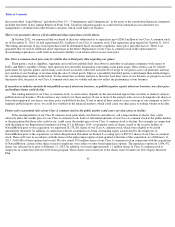Zynga 2014 Annual Report Download - page 34
Download and view the complete annual report
Please find page 34 of the 2014 Zynga annual report below. You can navigate through the pages in the report by either clicking on the pages listed below, or by using the keyword search tool below to find specific information within the annual report.
Table of Contents
revenue sources than we do and may be less severely affected by changes in consumer preferences, regulations or other developments that may
impact our industry. In addition, we have limited experience in developing games for mobile and other platforms and our ability to succeed on
those platforms is uncertain. We expect new game competitors to enter the market and existing competitors to allocate more resources to develop
and market competing games and applications.
As there are relatively low barriers to entry to develop a mobile or online casual game, we expect new game competitors to enter the
market and existing competitors to allocate more resources to develop and market competing games and applications. We also compete or will
compete with a vast number of small companies and individuals who are able to create and launch games and other content for devices and
platforms using relatively limited resources and with relatively limited start-up time or expertise. The proliferation of titles in these open
developer channels makes it difficult for us to differentiate ourselves from other developers and to compete for players without substantially
increasing our marketing expenses and development costs. Increasing competition could result in loss of players, loss of talent or loss of our
ability to acquire new players in a cost-effective manner, all of which could harm our business.
Our revenue may be harmed by the proliferation of “cheating” programs and scam offers that seek to exploit our games and players affects
the game-playing experience and may lead players to stop playing our games.
Unrelated third parties have developed, and may continue to develop, “cheating” programs that enable players to exploit vulnerabilities in
our games, play them in an automated way or obtain unfair advantages over other players who do play fairly. These programs harm the
experience of players who play fairly, may disrupt the virtual economies of our games and may reduce the demand for virtual items. In addition,
unrelated third parties attempt to scam our players with fake offers for virtual goods or other game benefits. We devote significant resources to
discover and disable these programs and activities, and if we are unable to do so quickly our operations may be disrupted, our reputation
damaged and players may stop playing our games. This may lead to lost revenue from paying players, increased cost of developing technological
measures to combat these programs and activities, legal claims relating to the diminution in value of our virtual currency and goods, and
increased customer service costs needed to respond to dissatisfied players.
We may be required to record impairment related to our goodwill, intangible assets or other long-lived assets if our market capitalization
declines below our net asset value or if our financial performance and/or condition deteriorates.
As of December 31, 2014, we had $1.03 billion of goodwill, intangible assets and other long-
lived assets. Our February 2014 acquisition of
NaturalMotion increased our reported goodwill and intangible assets. If our market capitalization declines below our net asset value or if our
financial performance and/or condition deteriorates, we may have to impair our goodwill, intangible assets or other long-lived assets, which
could adversely impact our results of operations and financial position. For example, in the third quarter of 2012, we made the decision to
discontinue the development of certain games associated with technology and other intangible assets previously acquired from OMGPOP, Inc.
and we recorded an asset impairment charge of $95.5 million. In addition, in the third quarter of 2013 we recorded an intangible asset
impairment charge of $10.2 million related to various prior acquisitions. For more information, see Note 6—“Goodwill and Other Intangible
Assets” in the notes to the consolidated financial statements included elsewhere in this Annual Report on Form 10-K.
Failure to protect or enforce our intellectual property rights or the costs involved in such enforcement could harm our business and
operating results.
We regard the protection of our trade secrets, copyrights, trademarks, service marks, trade dress, domain names, patents, and other product
rights as critical to our success. We strive to protect our intellectual property rights by relying on federal, state and common law rights, as well as
contractual restrictions. We enter into
31


